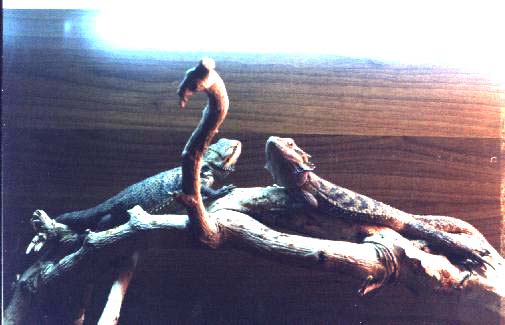
POGONA VITTICEPS
important: in advance to buy any reptiles be sure to have a cage sufficiently big with ideal temperatures and INQUIRE, INQUIRE, INQUIRE
click here for Mickey and Mallory gallery
| common name: | inland bearded dragon | ||||
| size: | adults can reach 24 inches in length,
females are usually smaller than males; Hatchlings have an average growth rate (mine
are grown about 12 inches in six months)
|
||||
| cage: | Bds are very active, so they need as minimum a cage of 60x20x24 inches, with branches and hiding logs | ||||
| substrat: | Is better to avoid gravel and barks and there is a debate about using play sand because could be deadly if ingested, certainly must be avoided with hatchling; are advised newspapers or syntethic turfs (to change or wash often), with my adults I'm using successfully rabbit pellets, but I haven't a water bowl in the cage | ||||
| lighting and heating: | lizards to synthetize vit D3 needs UVB (click here for other informationsi), so is advisable use of fluorescent as Zoomed Reptisun 5.0 also if there is a debate about real effectiveness of fluorescent UVB tubes, and have lizards out in the sun in big mesh cages (plastic and glass filter UVB). Lights on for 8/12 hours a day ( depending on seasons) and don't have any visible light on at night. For heating you can use normal lamps, infrareds, ceramic heat lamps..., is very important to have the heat source connected to a thermostat and to have 2 thermometers (1 in warm side and 1 in cold side) to always check temperature. Hot rocks are to avoid because cause burns. Day temps must be 73/75F in the cold side, 86F in the warm side and a basking area of 90/98F. Nighttemp never drop down 72F for hatchlings, adults tolerate lower temperature | ||||
| feeding: | seldom drink from a water bowl so hatchlings need hand spray 2/3 times a day, adults take water from aliments and need hand spray only to promote shedding. Hatchlings are primarily insectivorous and can eat 50 crickets divided in 3/5 feeds a day, growing is necessary to increase vegetables (up to 60% of the diet) and decrease insects.Is important feed small prey (maximum big as the distance of bd eyes), when prey is too large could result problems as paralysis or even death. Often hatchlings don't eat vegetables, I encouraged mine putting small white mealworms ( white are freshly molted ones, others are too much chitinous and are few digestible)in the salad. As vegetables I use Iggy's salad. As insects you can offer crickets, king worms and locusts. Waxworms and pinkies are too rich in fats and you can use only as an occasional delicacy. ATTENTION: LIGHTNING BUGS ARE DEADLY! | ||||
| supplements: | youngs need calcium+vit D3 every day and vitamins 1/2 times a week; adults need calcium+vit D3 every 2/3 feeds, vitamins 2 time a week. |